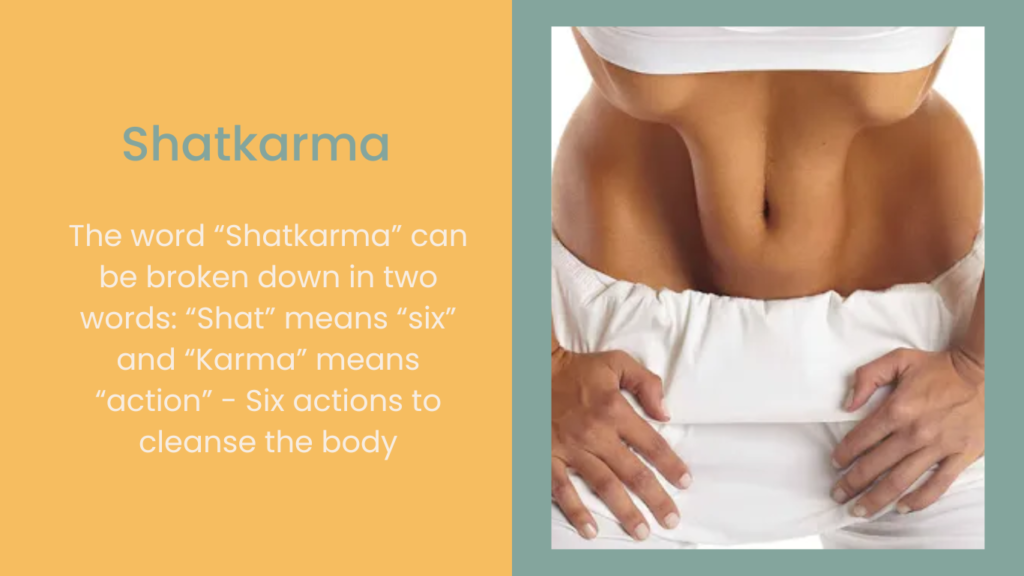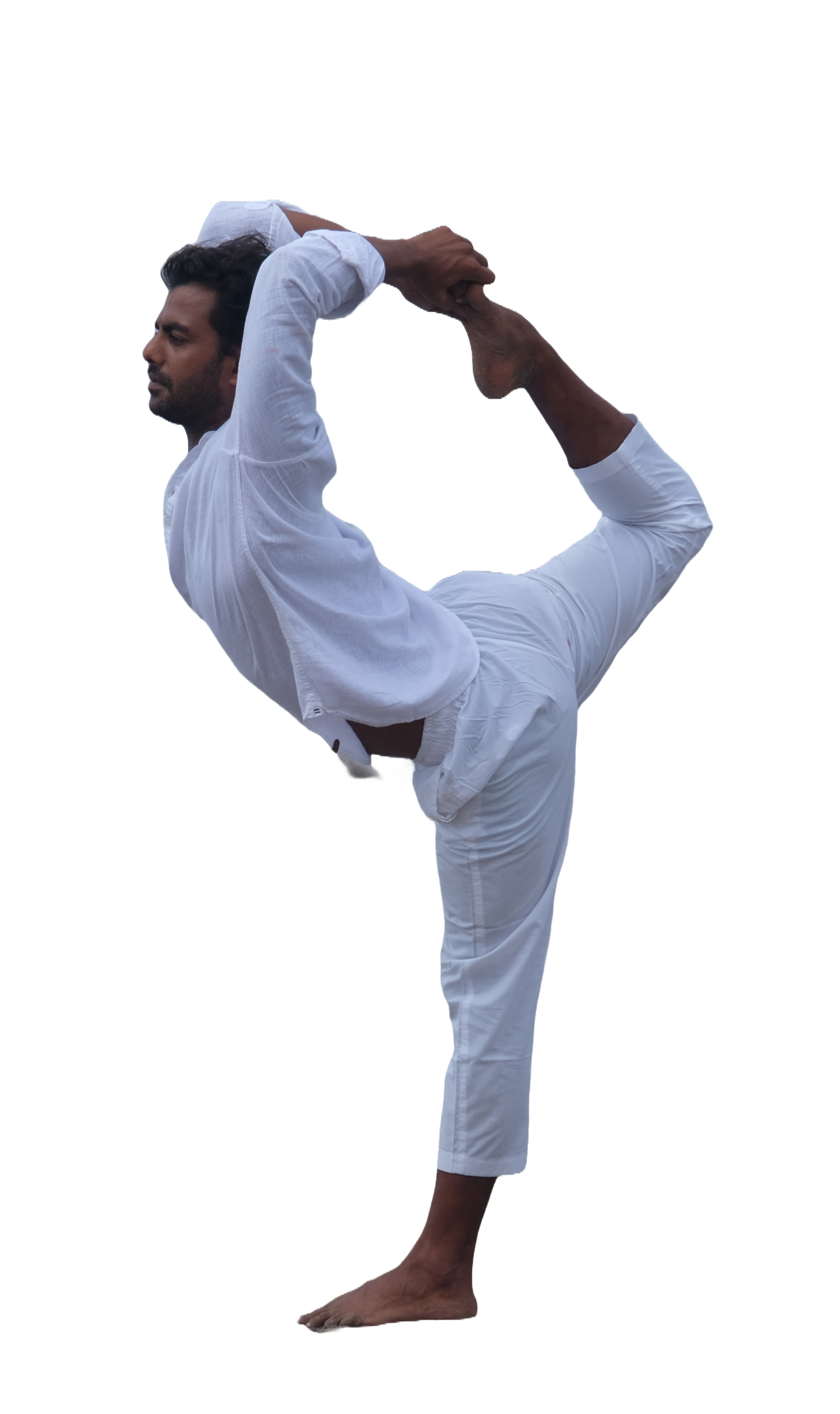What is Shatkarma?
The word “Shatkarma” can be broken down in two words: “Shat” means “six” and “Karma” means “action” – Six actions to cleanse the body
Shatkarma involves six cleansing techniques that help harmonizing our two main Nadis “Ida and Pingala”. This purification creates balance in our physical and mental body. In Hatha yoga practice, Shatkarma is performed before starting the higher sadhana (spiritual practice) and pranayama to free the body from toxins and diseases to remove all barriers of the spiritual journey.
Exploring the Six Shatkarma Cleansing Techniques
In the Gheranda Samhita, a hatha yoga scripture , the six different cleansing techniques are explained. Through the practice of shatkarma you prepare yourself for higher practice of yoga. It is not only physical purification but also to purify the inner self – Impurities do not always have a physical origin, but they can have their root in mental and emotional imbalances as well.
1. Physical aspect of body
Physical body health is directly related to diet and thus what kind of food you consume. “We are what we eat”. In the yogic anatomy our physical body or food body is called Anamaya kosha. Now a days, our food consists of many impure elements, like chemical fertilizers and pesticides to increase the quantity of crop. In the Hindu tradition food should be eaten after sunrise and before sunset, but in our modern lives many people eat dinner late, sleep a midnight and wake up late and have their breakfast late and work against the natural cycle, which can be a cause of illness and disease. As we cannot control the whole food chain and usually buy food from the market or supermarket, some impurities remain. But we can make some adjustments, that can reduce the amount of toxins we take in through our food. We can choose to consume non-processed whole fruits and vegetables, we can choose from where we buy our produce, we are in charge of the preparation and cooking of the meals and we can also decide the meal times.
The Physical Aspect of the Six Shatkarma Cleansing Techniques
Meals should be taken two or three times per day. Fifty percent of stomach should be filled with healthy and nutritious food, twenty five percent with liquids and the remaining twenty five percent should remain empty. Unfortunately, people tend to overeat, which can cause digestive disorders and reducing the vitality and energy levels.
2. Mental stress
Mental stress and disorders including anxiety, depression, mood swings, tension, worries and negative thoughts directly affect our physical body. We can experience it as pain, lethargy, loss of appetite. Mental stress lingers in the physical body and Shatkarma helps to release this tension.
3. Emotional impurities
Happiness or sorrow, love or hate, all these states directly affect our hormonal system. If you are in a joyful state your adrenal glands secrete dopamine the “happy hormone”. The glands release the stress hormones adrenaline and cortisol, when we are angry or scared as part of our fight and flight response. Thus our emotions directly affect our physical body.
Shatkarma is a holistic practice that helps to regulate the different system of the body and frees these systems from physical, mental and emotional impurities.
The six Shatkarma techniques are Dhauti, Basti, Neti, Nauli, Trataka and Kapalbhati
Dhauti
The first technique is dhauti. It involves cleansing the alimentary canal and digestive tract. Antar dhati, danta dhauti, hrid dhauti, and moola shodhana are the four different forms of dhauti. For the practice of dhauti, water, a cloth or air can be used. Numerous stomach disorders can be treated using these methods. Dhauti is a practice that can be used to treat hyperacidity, irritable bowel syndrome, constipation, and other abdominal diseases.
Basti
Bast is also called Yoga enema. For the practice of basti, water is sucked up through the anus and held for a while in the large intestine. Water remains in the large intestine and does not pass into the small intestine. Similar to a typical enema, the water is eventually ejected. The sole distinction is that an enema employs a tube, whereas during basti no tube is used, making this a more natural approach. It is an advanced technique that involves pulling the abdomen in and up.
Yoga practitioners advise basti rather than an enema. However, practice is necessary before the method is perfected, and a rubber tube or catheter is needed while learning the skill.
Neti
Neti is also called nasal cleansing and purifies the nose, sinuses, ears and throat. The process of “sutra neti” – inserting a thread in one nostrils and taking it out from the mouth is described in Hatha Yoga scriptures. Jal Neti is the cleansing with water. For this water streams into one nostril and out the other nostril. The benefits are immediately noticeable by freer breathing, because the neti clears the sinuses and nasal passages. Neti is especially beneficial for persons who have sinusitis, rhinitis, headaches, migraines, or chronic frontal headaches, impaired vision, eye tiredness, wetness after reading, eye congestion, eye pain or throat irritation. It is also beneficial for those who have minor ear issues like excess wax and hardened wax, which can irritate the eardrums.
Lauliki
Lauliki, also known as nauli, is the fourth Shatkarma and it includes four different techniques . It is a potent technique that strengthens and massages every abdominal organ and should be avoided by patients with hernias. Those who have intestinal worms, indigestion, or a loss of appetite ought to practice it. Additionally, it is helpful for reducing too much vata or wind in body
Trataka
The fifth practice is trataka – steady gazing. It can be practiced with any object. Try to look at the object without blinking for as long as possible. It is helpful for balancing the nervous system and removing eye issues. It can, for example, help to remove nervous tics or uncontrolled nervous activity, such as one eye blinking. Trataka can relieve eyestrain, shortsightedness, farsightedness, myopia or other eye defects in a healthy body. Experience has also shown that with the practice of trataka alone, one can remove eye defects like shortsightedness. It is also used as preparatory process for pratyahara and dharna.
Kapalbhati
The sixth exercise is known as kapalbhati. This cleansing method can assist to improve lung health while also clearing the mind. As more oxygen is taken in and more carbon dioxide is exhaled, the trachea or windpipe becomes free of disease and the blood is cleaned. Autonomic nerve system imbalances and mental disorders can be treated with kapalbhati. According to different research, kapalbhati and sukshma vyayama can be used to increase memory retention in old age.
In the following articles we are going to explore these different techniques in more detail.
If you like to dive deeper into the practice of Shatkarma and practice them under the guidance of an experienced teacher come and join us for our 200 h Yoga teacher training in Bali and 300 hour Yoga teacher training course in Bali
Integrating Shatkarma in our 200 Hour Teacher Training
Incorporate the ancient wisdom of Shatkarma into your 200 Hours Teacher Training course in Bali and take your yoga instruction to the next level. Discover how these cleansing practices can enhance your teaching skills, deepen your understanding of yoga, and help your students achieve holistic well-being. Join us on this transformative journey of integration and empowerment.
Popular Courses in Bali
200 hour Yoga Teacher Training in Bali | 300 hour Yoga Teacher Training in Bali | 500 hour Yoga Teacher Training in Bali | 50 Hours Yin Yoga Training in Bali | 50 hours Pranayama Training in Bali | 50 hours Yoga Nidra Training Bali | 50 hours Arm Balancing Training Bali | 100 hour Ashtanga Training Bali
Popular Courses in Germany
200 hour Yoga Teacher Training in Germany | 300 hour Yoga Teacher Training Germany | 50 Hour Yin Yoga Training Germany | 50 Hour Pranayama Training Germany | 50 hour Yoga Nidra Training Germany | 50 Hour Arm Balancing Training | 100 hour Ashtanga Training Germany


